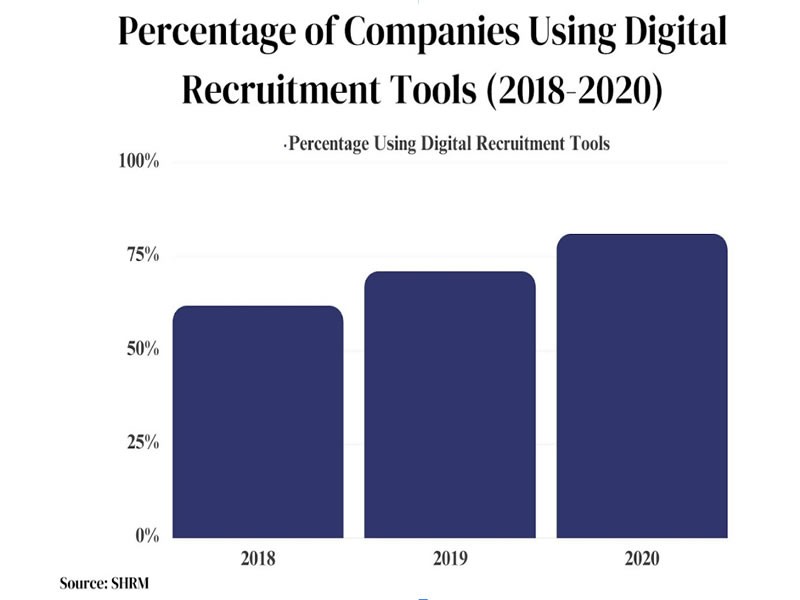Insight Blog
Agility’s perspectives on transforming the employee's experience throughout remote transformation using connected enterprise tools.
6 minutes reading time
(1179 words)
The Future of Work: Challenges and Solutions in HR Management
In this blog, we will explore some of the key shifts resulting in HR digital transformation and how businesses can adapt.
The world of work and HR management is undergoing major transformation. From recruitment to payroll, human resources (HR) management is embracing new technology and evolving practices to meet the complex challenges companies face today.
As a HR professional, staying updated on the latest trends is crucial to thrive in this digital era. In this blog, we will explore some of the key shifts resulting in HR digital transformation and how businesses can adapt.
Revolutionizing Recruitment and Onboarding in the Digital Era
The process of finding and recruiting the talented ones has evolved significantly in years moving away from traditional methods like newspaper ads and job fairs.
Nowadays, digital platforms offer a reach and the ability to automate aspects of hiring. According to SHRM 75% of HR professionals acknowledge that technology has empowered them to take on a strategic role.
The bar chart depicts the percentage of companies using digital recruitment tools in 2018, 2019 and 2020.
The percentage has grown from 62% to 71% to 81% over the 3 year period. It shows the increasing adoption of these technologies
With the help of AI driven tools candidate searches have become faster and more efficient. For instance, chatbots are now able to screen applicants and schedule interviews, reducing hiring cycles by up to 40% as stated by Gartner.
Another exciting advancement is the integration of reality (VR) and augmented reality (AR) in onboarding processes. These robust technologies provide newcomers with real time insights into their day to day responsibilities.
By relying on training manuals, new hires can now gain hands-on experience through interactive simulations. This engagement boosting element also enhances orientation programs. It also eases the work of HR managers significantly.
That said, it still remains crucial to stay attentive and vigilant throughout these advancements. HR leaders must ensure that the algorithms powering these technologies are fair and unbiased. Striking a balance between onboarding techniques and face to face interactions is needed now more than ever.
Modernizing Employee Time Clock and Clock In-Clock Out Mechanisms
The traditional method of punching a time clock is gradually becoming obsolete. Nowadays companies are adopting systems to monitor working hours, locations and more. According to Deloitte implementing automated employee time clock solutions has led to a 20% increase in productivity.
Clock in Clock out apps are also gaining popularity in this regard. Employees can conveniently clock in or out using their smartphones regardless of their location. By utilizing GPS tracking businesses can verify attendance.
Gain insights into peak operating times. McKinsey reports that these mobile solutions have reduced payroll errors by up to 15%.
Another advantage is the access to data and real time visibility provided by these systems. Managers no longer have to wait until payday to address issues such as absenteeism or early departures. Automated alerts promptly notify them of any anomalies so that they can take action in a manner.
However, it is crucial for businesses to find the balance between monitoring employees and respecting their privacy. For instance location data should be. Encrypted for protection. The main focus should be on safeguarding interests without being excessively intrusive.
Advancements in Employee Scheduling and Time Tracking
Juggling schedules across multiple locations, job roles, and employee needs is a complex undertaking. Thankfully, technology is stepping in to remove the guesswork.
There are cloud-based systems that use data and predictions to figure out how many people are needed for different jobs. These systems get better over time and make schedules that match what's needed. How so? Well, about 60% of businesses have seen happier employees after using these solutions, according to PwC.
Keeping track of time is also easier with technology. There are apps that let remote teams log their work hours, record tasks they can charge money for, and keep an eye on deadlines. Advanced tools have even helped companies avoid running late on projects by up to 25%, says McKinsey.
Even with all this tech, managers still need to talk to their teams. Technology can't replace one-on-one conversations about goals, challenges, and career growth. On the whole, it's important to keep communication open.
Follow us and access great exclusive content everyday: Follow us on Google News
Redefining Hourly Salary in Today's Work Landscape
The nine, to five paradigm is facing challenges from the rise of the gig economy. Freelancing, contract work and flexible jobs are becoming increasingly common among Millennials and Gen Z. According to McKinsey this diverse workforce now represents 36% of the labor market in the United States.
To adapt to this shift companies are embracing wages. This allows workers to have control over their schedules while their pay is directly tied to the amount they work. This arrangement benefits both employers and employees in today's landscape.
Deloitte reports that companies that provide information about wages have seen a decrease of approximately 10% in employee turnover. When workers have an understanding of what they will earn they can make choices that align with their personal lives.
However, it remains crucial for businesses to ensure compensation for all workers and provide benefits such as healthcare and retirement plans—similar to those offered to full time employees. Maintaining fairness is pivotal for ensuring employee satisfaction.
As our working patterns continue evolving, HR departments must adapt accordingly. While technology plays a role we should never underestimate the importance of connection. Companies that strike a balance between leveraging technology and prioritizing employee well being will thrive in this era.
As we embrace the transformation, in HR it is important to never lose sight of the individuals we're here to assist.
Frequently Asked Questions
How is technology changing the way companies find and hire new employees?
Companies now use new digital tools to find candidates faster. For example, chatbots can quickly screen applicants and schedule interviews. Virtual reality can also give potential hires a realistic preview of the job. However, it's still important to maintain personal connections during hiring.
You may also like: Best Apps for Employees: UPDATED 2022 – A Complete Guide
What are some of the benefits of digital systems for tracking employee hours?
Digital time clocks and mobile apps make it easier and more accurate to record hours worked. Managers can access real-time data to address issues like absenteeism right away. However, companies need to make sure to balance tracking performance with employee privacy.
How is scheduling changing with new technologies?
Scheduling systems use data to predict staffing needs. This takes a lot of the guesswork out of scheduling and makes the process more efficient. Employees tend to be happier working schedules created this way. However, its managers should still talk to teams about goals and challenges.
Free ebook: How To Get Your Intranet Off The Ground
Categories
Blog
(2640)
Business Management
(325)
Employee Engagement
(212)
Digital Transformation
(177)
Growth
(120)
Intranets
(119)
Remote Work
(61)
Sales
(48)
Collaboration
(37)
Culture
(29)
Project management
(29)
Customer Experience
(26)
Knowledge Management
(21)
Leadership
(20)
Comparisons
(6)
News
(1)
Ready to learn more? 👍
One platform to optimize, manage and track all of your teams. Your new digital workplace is a click away. 🚀
Free for 14 days, no credit card required.















